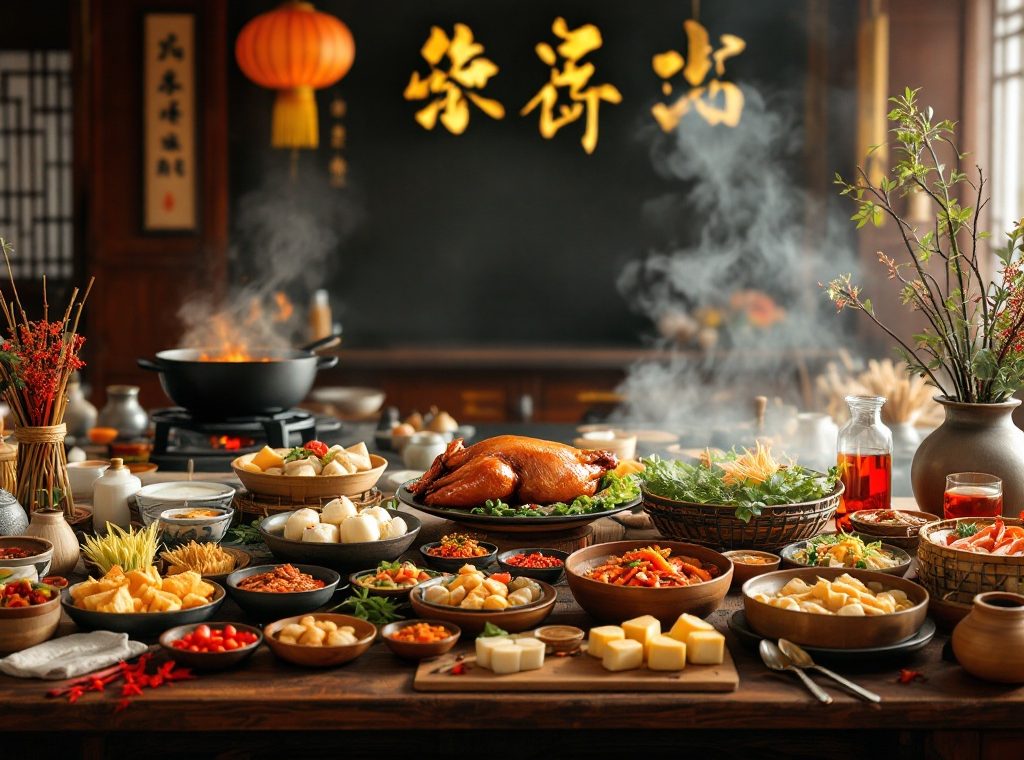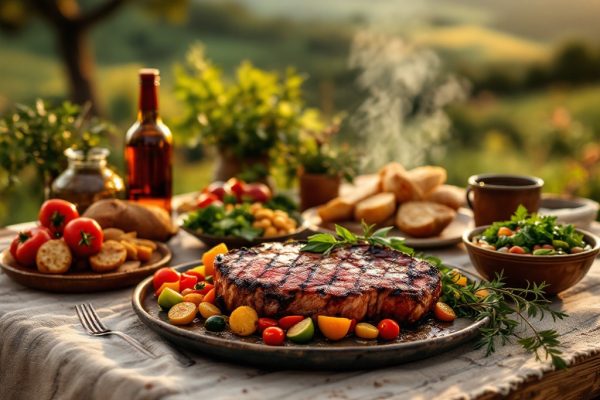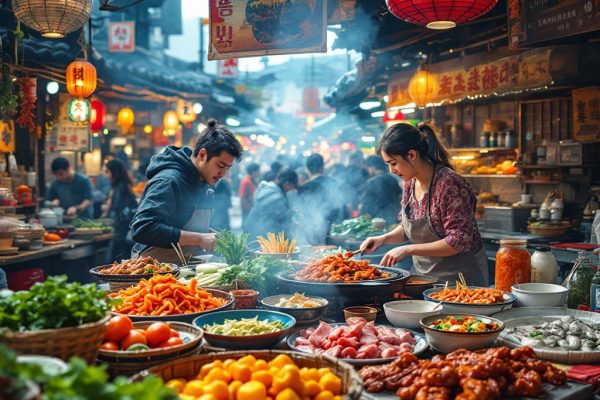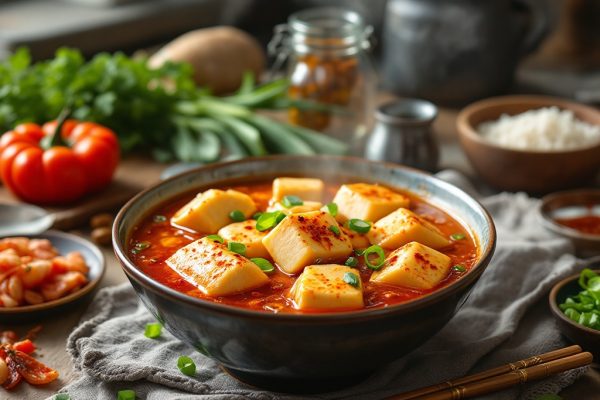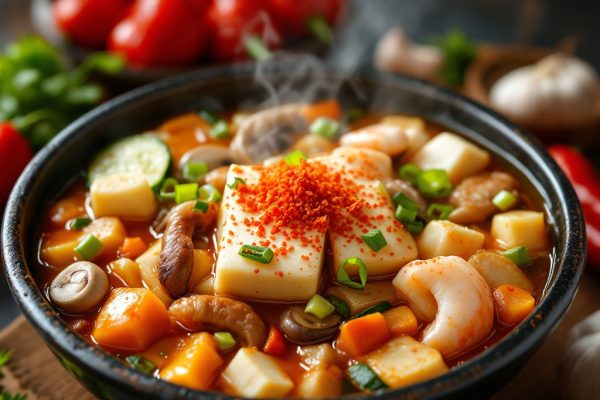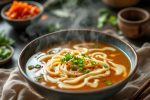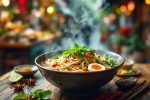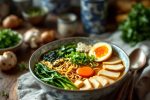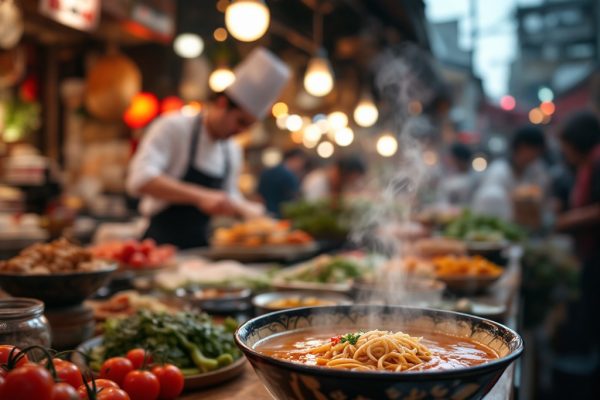Different Style of Chinese Cuisine
Embark on a culinary journey through the eight major traditions of Chinese cuisine! From the fiery spice of Sichuan and Hunan to the delicate freshness of Cantonese and Zhejiang, discover a world of diverse flavors. Explore signature dishes like Peking duck and Mapo tofu, and learn about essential ingredients and cooking techniques, including wok hei and the art of braising. Uncover the secrets of dim sum, hot pot variations, and regional specialties. Dive into the rich tapestry of Chinese culinary heritage and start exploring today!
Important information
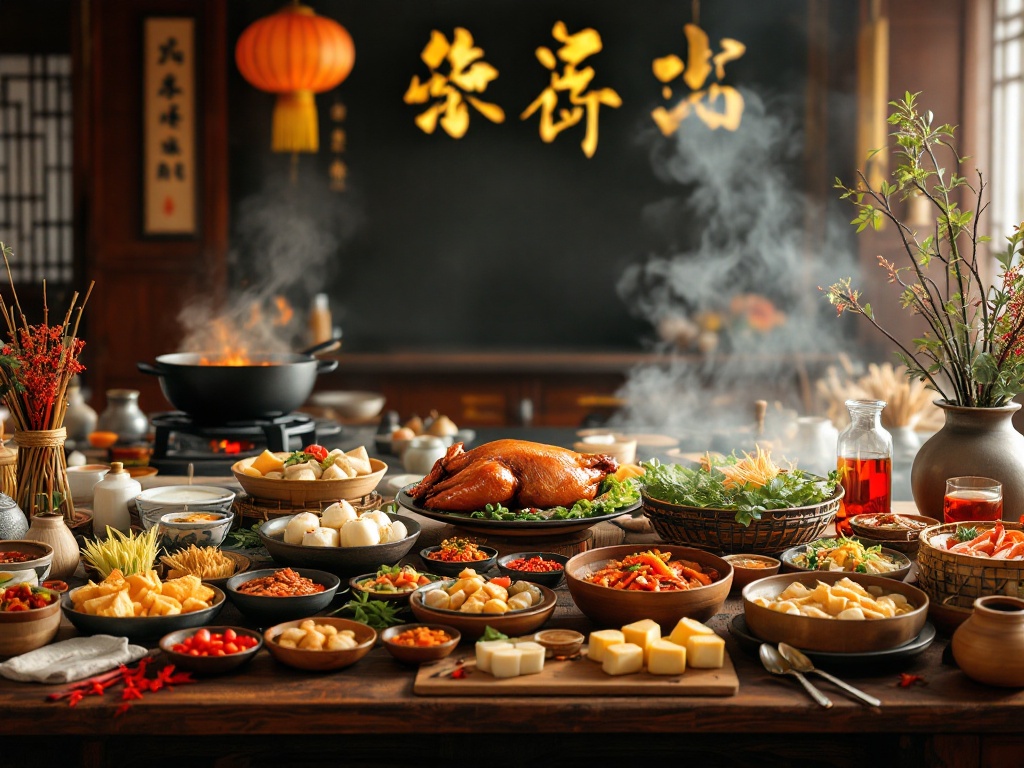
- Eight major Chinese cuisines include Cantonese (fresh, delicate), Hunan (fiery hot and sour), Zhejiang (light, seafood-focused), Shandong (vinegar and seafood), Sichuan (bold spices, Sichuan peppercorns), Jiangsu (sweet and savory), Fujian (diverse seafood, flavorful soups), and Anhui (wild herbs and game).
- Key ingredients across Chinese cuisine include soy sauce, rice vinegar, ginger, garlic, and scallions.
- Popular cooking methods include wok cooking (high heat, “wok hei” smoky flavor), steaming (preserves nutrients), braising (tenderizes meats), frying (crispy textures), and stewing (deep, complex flavors).
- Regional variations exist in dishes like hot pot, with Sichuan emphasizing spice, Guangdong highlighting seafood, and Beijing favoring mutton.
- Signature dishes include Peking duck (crispy skin), Mapo tofu (Sichuan peppercorns), dim sum (Cantonese small bites), and West Lake fish (sweet and sour).
The Eight Major Traditions of Chinese Cuisine
Cantonese (Yue) cuisine tantalizes with fresh ingredients and delicate flavors.
Hunan (Xiang) cuisine delivers a fiery hot and sour punch.
Zhejiang (Zhe) cuisine showcases the bounty of the sea with fresh seafood and light flavors.
Shandong (Lu) cuisine gets its distinctive character from vinegar and seafood.
Sichuan (Chuan) cuisine explodes with bold spices like chili peppers and Sichuan peppercorns.
Jiangsu (Su) cuisine is the perfect choice for a balance of sweet and savory.
Fujian (Min) cuisine also embraces the ocean, incorporating diverse seafood and emphasizing flavorful soups.
Anhui (Hui) cuisine, reflecting its mountainous terrain, features wild herbs and game.
Cantonese Cuisine (Yue Cuisine)
Cantonese, or Yue, cuisine is renowned for its fresh flavors achieved through simple cooking methods like stir-frying, steaming, and braising. This results in delicious, natural tastes, perfectly exemplified by the globally popular dim sum. Cantonese food offers a refreshing approach to Chinese cuisine, promising a true culinary adventure.
Sichuan Cuisine (Chuan Cuisine)
Sichuan cuisine, also known as Chuan cuisine, is renowned for its bold and spicy flavors, stemming from the unique numbing sensation of Sichuan peppercorns. The cuisine’s complexity goes beyond mere heat, artfully balancing spicy, sweet, sour, and savory notes. Common ingredients like garlic, ginger, chili peppers, and fermented sauces contribute to this dynamic flavor profile. Dishes like Kung Pao chicken and Mapo tofu perfectly exemplify these signature tastes.
Hunan Cuisine (Xiang Cuisine)
Hunan cuisine, also known as Xiang cuisine, is famed for its fiery heat due to the generous use of chili peppers. Garlic and shallots also play a key role in its distinctive flavor. Smoked and cured meats are frequently used. Unlike Sichuan cuisine, which balances heat with numbing spices, Hunan emphasizes pure heat. It also features fresh, local ingredients, creating vibrant and flavorful dishes.
Jiangsu Cuisine (Su Cuisine)
Jiangsu cuisine, also known as Su Cuisine, is one of China’s eight great culinary traditions. It’s renowned for its intricate techniques, subtle flavors, and emphasis on fresh, seasonal ingredients. The cuisine features three distinct styles: Jinling, Huaiyang, and Suxi. Freshwater fish and seafood from the region’s rivers and lakes, along with diverse vegetables, are central to many dishes. Braising and stewing are favored cooking methods. Sugar and soy sauce add a touch of sweetness, yet the overall taste remains delicately balanced. Signature dishes like Sweet and Sour Mandarin Fish and Yangzhou Fried Rice exemplify this balance. Other notable dishes further showcase Jiangsu’s culinary expertise.
Zhejiang Cuisine (Zhe Cuisine)
Zhejiang cuisine, also known as Zhe Cuisine, is renowned for its fresh seafood and diverse cooking methods. It emphasizes light, delicate flavors achieved through techniques like steaming, stir-frying, and braising. A hallmark of Zhe Cuisine is its use of vinegar, adding a distinctive tanginess, perfectly exemplified by the classic West Lake Fish in Vinegar Gravy. Fresh, seasonal ingredients are prioritized, particularly seafood from the East China Sea and tender bamboo shoots.
Fujian Cuisine (Min Cuisine)
Fujian (or Min) cuisine is known for its delicate, fresh dishes, often featuring seafood and flavorful soups. The cuisine masterfully blends sweet, sour, and savory tastes, frequently incorporating ingredients like mushrooms and bamboo shoots. Braising and stewing are common cooking methods, resulting in tender and flavorful dishes. A prime example is the iconic Buddha Jumps Over the Wall, a rich and complex culinary experience.
Shandong Cuisine (Lu Cuisine)
Lu cuisine, also known as Shandong cuisine, originates from China’s Shandong province and is one of the Eight Culinary Traditions. It’s celebrated for its fresh seafood, flavorful soups, and rich, savory dishes. Shandong chefs typically use braising, frying, and steaming techniques. Key ingredients include vinegar, garlic, and soy sauce. A signature dish, sweet and sour carp, perfectly embodies this culinary style, offering a unique taste of Lu cuisine.
Anhui Cuisine (Hui Cuisine)
Anhui (or Hui) cuisine is known for its distinctive flavors, showcasing local ingredients like wild game and herbs from the province’s mountainous regions. Slow cooking methods, such as braising and stewing, create deep, savory flavors. The use of tofu and fermented products further enhances these rich tastes. Signature dishes include Bamboo Shoots with Ham and Stewed Soft Shell Turtle, both offering a delicious glimpse into Anhui’s culinary heritage.
Other Notable Regional Chinese Cuisines
Hakka cuisine is an explosion of flavor, featuring preserved ingredients. Yunnan food, incredibly diverse due to ethnic influences, incorporates unique ingredients like wild mushrooms and edible flowers. Xinjiang cuisine, known for its roasted meats, showcases Central Asian influences.
Teochew cuisine emphasizes fresh seafood and delicate broths. The hearty stews and dumplings of Northeastern cuisine offer warmth against the region’s colder climate.
Hakka Cuisine
Hakka cuisine is known for its robust flavors, particularly its emphasis on preserved ingredients and stuffed dishes. Stuffed tofu, a Hakka staple, often features a savory filling of preserved meats and vegetables, creating a distinctive and flavorful culinary experience.
Teochew Cuisine
Teochew cuisine is known for its emphasis on fresh seafood, creating light yet flavorful dishes. Chefs typically steam, stir-fry, or braise ingredients to preserve their natural flavors, resulting in a delicate and delicious dining experience. Teochew cuisine offers a unique culinary experience, highlighting the natural sweetness and freshness of seafood. The delicate cooking methods employed by Teochew chefs ensure that the dishes are both healthy and flavorful. Whether steamed, stir-fried, or braised, each dish showcases the essence of the ingredients, creating a harmonious blend of textures and tastes.
Yunnan Cuisine
Yunnan cuisine offers a unique culinary adventure, influenced by the region’s diverse geography and ethnic cultures. Its mountainous terrain provides a rich variety of ingredients, including wild mushrooms and edible flowers. Situated near Southeast Asia, Yunnan’s cuisine also features tropical fruits and incorporates culinary traditions from neighboring countries, creating a truly special and flavorful experience.
Northeastern Cuisine
Northeastern Chinese cuisine offers hearty, flavorful dishes, influenced by the region’s chilly climate and proximity to Mongolia and Russia. Wheat, potatoes, and cabbage are staples, providing comfort and sustenance against the cold. These ingredients frequently appear in warming stews, savory dumplings, and juicy roasted meats. This cultural blend creates a unique culinary experience.
Xinjiang Cuisine
Xinjiang cuisine offers a delicious fusion of Chinese and Central Asian flavors, featuring bold spices like cumin and chili. Imagine vibrant, aromatic dishes such as smoky lamb kebabs. For a heartier meal, try the satisfying laghman noodles. Don’t miss the soft, pillowy nang bread. This cuisine is a true culinary adventure, blending familiar Chinese elements with exciting new tastes. It’s a must-try for any food enthusiast.
Signature Dishes and Ingredients in Chinese Cuisine
Peking duck, hailing from Beijing, is prized for its crispy skin and succulent meat. Mapo tofu, a Sichuan staple, blends tofu with fermented black beans and chili bean sauce for a fiery kick. Cantonese dim sum presents a delightful array of small, steamed or fried dishes, from dumplings and buns to savory rolls. Hunan cuisine, famed for its heat, often features chilies, garlic, and shallots. West Lake fish, a Zhejiang delicacy, offers a subtle sweet and sour taste.
Key ingredients that underpin the diversity of Chinese cooking include:
- soy sauce,
- rice vinegar,
- ginger,
- garlic, and
- scallions.
Dim Sum and Dumplings
Dim sum, a Cantonese culinary tradition, offers a delightful array of small, savory bites. These include steamed and fried dumplings, buns, and rolls. A staple in many Chinese cuisines, dumplings are pockets of dough filled with various ingredients. They are cooked in a variety of ways, including boiling, steaming, pan-frying, or deep-frying.
Hot Pot Variations
Hot pot is a communal dining experience with diverse regional variations across China. Diners select and cook ingredients tableside in a simmering broth.
Sichuan Hot Pot
Renowned for its fiery spice, Sichuan hot pot offers a thrilling culinary adventure for those who enjoy intense flavors.
Guangdong Hot Pot
Featuring fresh seafood, Guangdong hot pot emphasizes the delicate sweetness of the ocean’s bounty.
Beijing Hot Pot
Favoring mutton, Beijing hot pot provides a rich and savory experience, highlighting the robust flavor of the meat.
Rice and Noodle Dishes
Rice and noodles are fundamental ingredients in Chinese cuisine. From chow mein to lo mein, and the beloved fried rice, these versatile dishes easily adapt to regional tastes and various ingredients, establishing their status as staples across China.
Seafood Specialties
Cantonese Cuisine
Cantonese cuisine is famous for its fresh seafood, often prepared with simple steaming or stir-frying techniques. A classic example is steamed fish, delicately flavored with ginger and scallions, or prawns sautéed with garlic.
Jiangsu Cuisine
Jiangsu cuisine prefers freshwater seafood. A popular dish is hairy crab, simmered in fragrant Shaoxing wine.
Fujian Cuisine
Fujian cuisine features sweet and sour notes, incorporating ingredients like prawns, fish, and squid.
Shandong Cuisine
Shandong cuisine, from China’s northern coast, emphasizes braising and quick frying. This results in dishes like braised sea cucumber with scallions or a vibrant stir-fry of clams and ginger.
Spicy Delights: Sichuan Peppercorns and Spicy Chilies
Sichuan cuisine is characterized by the unique numbing sensation produced by Sichuan peppercorns. This tingling sensation is a key differentiator, setting it apart from the fiery heat of Hunan cuisine. A classic example is Mapo Tofu, a Sichuan staple that relies on these unique peppercorns for its characteristic flavor.
Hunan cuisine, while also known for its heat, focuses on a different flavor profile. It often features fresh, local ingredients and the rich flavors of smoked meats. While both cuisines employ similar cooking techniques like stir-frying and steaming, Sichuan peppercorns are rarely found in Hunan cooking.
Fermented Ingredients and Pickled Vegetables
Fermented black beans (douchi) are a cornerstone of Hunan and Sichuan cuisine, lending a deep, savory flavor to various dishes. Similarly, the pungent, salty tang of pickled mustard greens (zha cai) is a frequent highlight in Sichuan cooking. Preservation techniques like pickling are crucial not only for preventing spoilage, but also for developing unique and complex taste profiles. For instance, douchi contributes an earthy richness, while zha cai offers a sharp, briny bite. These ingredients showcase how preservation enriches culinary traditions with diverse and delicious flavors.
Culinary Techniques and Cooking Methods
Wok cooking uses intense heat to preserve freshness and create a smoky flavor known as “wok hei”. Steaming is ideal for dumplings and fish, locking in moisture and nutrients. Braising gently simmers ingredients in liquid for tender, flavorful results. Frying techniques range from stir-frying to deep-frying, creating a variety of textures. Stewing, a longer process, melds ingredients in liquid to develop rich, complex flavors.
Wok Cooking and Wok Hei
Wok cooking relies on high heat for fast, flavorful meals, a cornerstone of Chinese cuisine. A properly seasoned wok imparts “wok hei,” a prized smoky, slightly charred essence particularly celebrated in Cantonese dishes, adding a unique depth of flavor.
Steaming and Braising
Steaming, a fantastic way to maintain healthy meals, locks in vital nutrients and yields delicious results, like flavorful dim sum.
Braising, a slower cooking method, transforms tougher cuts of meat into incredibly tender dishes.
Both techniques enhance the natural flavors of food.
Frying and Stewing
Achieve a delightful crispiness with frying, often done in a wok. Think of crispy spring rolls and sesame balls. This technique delivers a satisfying crunch and texture.
Stewing, conversely, employs a gentler heat, slowly tenderizing ingredients and deepening their flavors. Succulent braised pork belly and rich stewed fish are prime examples. This method creates rich, flavorful dishes.
Both frying and stewing are staples of Chinese cuisine, highlighting its diverse culinary landscape.

